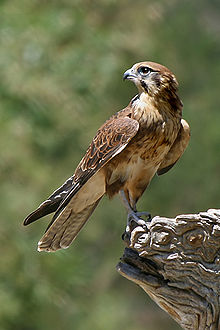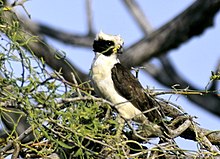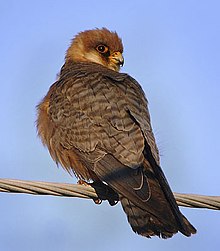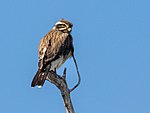Falconidae
| Falcons and caracaras | |
|---|---|

| |
| Brown falcon (Falco berigora) | |
| Scientific classification | |
| Domain: | Eukaryota |
| Kingdom: | Animalia |
| Phylum: | Chordata |
| Class: | Aves |
| Order: | Falconiformes |
| Family: | Falconidae Leach, 1819 |
| Type genus | |
Falco
, 1758 | |
| Subfamilies | |
|
Polyborinae Falconinae | |
The falcons and caracaras are around 65
Description
Falcons and caracaras are small to medium-sized birds of prey, ranging in size from the black-thighed falconet, which can weigh as little as 35 grams (1.2 oz), to the gyrfalcon, which can weigh as much as 1,735 grams (61.2 oz). They have strongly hooked bills, sharply curved talons and excellent eyesight. The plumage is usually composed of browns, whites, chestnut, black and grey, often with barring of patterning. There is little difference in the plumage of males and females, although a few species have some sexual dimorphism in boldness of plumage.
Distribution and habitat
The family has a cosmopolitan distribution across the world, absent only from the densest forest of central Africa, some remote oceanic islands, the high Arctic and Antarctica. Some species have exceptionally wide ranges, particularly the cosmopolitan peregrine falcon, which ranges from Greenland to Fiji and has the widest natural breeding distribution of any bird. Other species have more restricted distributions, particularly island endemics like the Mauritius kestrel. Most habitat types are occupied, from tundra to rainforest and deserts, although they are generally more birds of open country and even forest species tend to prefer broken forest and forest edges. Some species, mostly in the genus Falco, are fully migratory, with some species summering in Eurasia and wintering entirely in Africa, other species may be partly migratory. The Amur falcon has one of the longest migrations, moving from East Asia to southern Africa.[2]
Behaviour
Diet and feeding

Falcons and caracaras are carnivores, feeding on birds, small mammals including bats,
Breeding

The falcons and caracaras are generally solitary breeders, although around 10% of species are
Relations with humans
Falcons and caracaras have a complicated relationship with humans. In
Taxonomy and systematics
The
The composition of Falconidae is disputed, and Polyborninae is not featured in the
Falconinae, in its traditional classification, contains the falcons, falconets, and
Phylogeny
The following cladogram is based on a comprehensive
| Falconidae |
| ||||||||||||||||||||||||||||||||||||||||||||||||||||||||||||||||||
List of genera
Below is list of the subfamilies and genera of the Falconidae.[14]
| Subfamily | Image | Genus | Species |
|---|---|---|---|
| Herpetotherinae | 
|
Micrastur G.R. Gray, 1841 – forest falcons |
|

|
Herpetotheres Vieillot, 1817 – laughing falcon
|
| |
| Polyborinae | 
|
Spiziapteryx Kaup, 1852
|
|

|
Caracara Merrem, 1826 – crested caracara |
| |

|
Ibycter Vieillot, 1816
|
| |

|
Milvago Spix, 1824 – brown caracaras |
| |

|
Daptrius Vieillot, 1816
|
| |

|
Phalcoboenus d'Orbigny, 1834 |
| |
| Falconinae | 
|
Microhierax Sharpe, 1874 – typical falconets |
|

|
Polihierax Kaup, 1847
|
| |

|
Neohierax Swann, 1922
|
| |

|
Falco Linnaeus, 1758 – true falcons, hobbies and kestrels |
|
Fossil genera
- Badiostes (Santa Cruz Early Miocene of Patagonia, Argentina)
- Falconidae gen. et sp. indet. (Early Miocene of Chubut, Argentina)
- Falconidae gen. et sp. indet. (Pinturas Early/Middle Miocene of Argentina)
- Pediohierax (Middle Miocene of Nebraska, US) – formerly Falco ramenta
- Falconidae gen. et sp. indet. (Cerro Bandera Late Miocene of Neuquén, Argentina)[16]
- "Sushkinia" pliocaena (Early Pliocene of Pavlodar, Kazakhstan) – belongs in Falco?
- Thegornis (Miocene of South America)
References
- PMID 26824065.
- ^ Tordoff, Andrew (2002). "Raptor migration at Hoang Lien Nature Reserve, northern Vietnam" (PDF). Forktail. 18: 45–48. Archived from the original (PDF) on 2011-06-10.
- ^ Mikula, P., Morelli, F., Lučan, R. K., Jones, D. N., & Tryjanowski, P. (2016). Bats as prey of diurnal birds: a global perspective. Mammal Review.
- JSTOR 1367531.
- ^ Ille, R.; Hoi, H.; Grinschgl, F.; Zink, F. (2002). "Paternity assurance in two species of colonially breeding falcon: the kestrel Falco tinnunculus and the red-footed falcon Falco vespertinus". Etologica. 10: 11–15.
- ^ Leach, William Elford (1819). "Eleventh Room". Synopsis of the Contents of the British Museum (15th ed.). London: British Museum. pp. 63–68 [63]. The name of the author is not specified in the document, Leach was the Keeper of Zoology at the time.
- hdl:2246/830.
- ^ Myers, P. R.; C. S. Parr; T. Jones; G. S. Hammond; T. A. Dewey. "Subfamily Polyborinae (caracaras and forest falcons)". Animal Diversity Web. University of Michigan. Retrieved 2009-08-15.
- ^ "Check-list of North American Birds". North American Classification Committee. American Ornithologists' Union. Archived from the original on 2011-06-06. Retrieved 2009-08-15.
- ^ a b "A classification of the bird species of South America". South American Classification Committee. American Ornithologists' Union. Archived from the original on August 1, 2009. Retrieved 2009-08-15.
- ^ Myers, P. R.; C. S. Parr; T. Jones; G. S. Hammond; T. A. Dewey. "Subfamily Falconinae (falcons)". Animal Diversity Web. University of Michigan. Retrieved 2009-08-17.
- ^ "Check-list of North American Birds". North American Classification Committee. American Ornithologists' Union. Archived from the original on 2011-06-06. Retrieved 2009-08-17.
- ^ PMID 25256056.
- ^ Rasmussen, Pamela, eds. (January 2023). "Seriemas, falcons". IOC World Bird List Version 13.1. International Ornithologists' Union. Retrieved 4 February 2023.
- ^ Clements, J.F.; Schulenberg, T.S.; Iliff, M.J.; Fredericks, T.A.; Gerbracht, J.A.; Lepage, D.; Billerman, S.M.; Sullivan, B.L.; Wood, C.L. (2022). "The eBird/Clements Checklist of Birds of the World: v2022". Retrieved 4 February 2023.
- phalanx 1 of the middle toe. A caracara? Possibly belongs in extant genus. Kramarz, Alejandro: Garrido, Alberto; Forasiepi, Analía; Bond, Mariano & Tambussi, Claudia (2005): Estratigrafía y vertebrados (Aves y Mammalia) de la Formación Cerro Bandera, Mioceno Temprano de la Provincia del Neuquén, Argentina. Revista Geológica de Chile 32(2): 273–291. HTML fulltext
External links
- Falconidae videos, photos and sounds on the Internet Bird Collection
